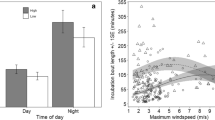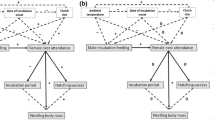Abstract
The resolution of the conflict between eggcare and foraging was studied in male and female wandering albatrosses. The foraging zone and range, duration of incubation shifts and foraging trips, and associated changes in body mass were studied. Costs during incubation, expressed as the time spent incubating and the proportional loss of body mass, were similar for both sexes. The mass gained at sea was related to the duration of foraging trips, but the relationship was much less significant in males, where foraging ranges, though similar on average to those of females, were very variable. Males foraged in more southerly waters than females, and gained mass more rapidly. Only females appeared to regulate the duration of foraging trips, and this compensated for the mass lost during the incubation fast. Previous breeding experience had no influence on foraging efficiency. Egg desertion because of depletion of body reserves was very rare because birds have a wide “safety margin”, i.e. the difference between the average body mass when relieved and that at nest desertion. This safety margin enables the birds to compensate for the high variability in the duration of foraging trips, and is probably a reason for the high breeding success of wandering albatrosses. Decisions to return from the sea to the nest or to desert the nest are probably related to the status of body reserves, and have been selected in the large wandering albatross so that both present and future reproductive success are maximised.
Similar content being viewed by others
References
Blem CR (1990) Avian energy storage. Curr Ornithol 7: 59–113
Boersma PD, Wheelwright NT (1979) Egg neglect in the procellariiformes: reproductive adaptations in the fork-tailed storm petrel. Condor 81: 157–165
Calder WA III (1984) Size, function and life history. Harvard University Press, Cambridge
Chastel O, Weimerskirch H, Jouventin P (in press) The influence of body condition on reproductive decision and reproductive success in the blue petrel. Auk, in press
Chaurand T, Weimerskirch H (1994) Incubation routine, body mass regulation and egg neglect in the blue petrel Halobaena caerulea. Ibis 136, in press
Clutton-Brock TH (1992) The evolution of parental care. Princeton University Press, Princeton
Croxall JP (1982) Energy costs of incubation and moult in petrels and penguins. J Anim Ecol 51: 177–194
Croxall JP, Ricketts C (1983) Energy costs of incubation in the wandering albatross Diomedea exulans. Ibis 125: 33–39
Davis LS (1988) Coordination of incubation routines and mate choice in adélie penguins (Pygoscelis adeliae). Auk 105: 428–432
Drent RH, Daan S (1980) The prudent parent: energetic adjustment in avian breeding. Ardea 68: 225–252
Fisher HI (1971) The Laysan albatross: its incubation, hatching and associated behaviour. Living Bird 10: 19–78
Fressanges du Bost D, Segonzac M (1976) Note complémentaire sur le cycle reproducteur du grand albatros (Diomedea exulans) de l'île de la Possession, Archipel Crozet. Com Nat Fr Rech Ant 40: 53–60
Johnstone RM, Davis LS (1990) Incubation routines and foraging trip regulation in the grey-faced petrel Pterodroma macroptera. Ibis 132: 14–20
Jouventin P, Weimerskirch H (1990) Satellite tracking of wandering albatrosses. Nature 343: 746–748
Mock DW, Parker GA (1986) Advantages and disadvantages of egret and heron brood reduction. Evolution 40: 459–470
Prince PA, Ricketts C, Thomas G (1981) Weight loss in incubating albatrosses and its implication for their energy requirements. Condor 83: 238–242
Prince PA, Rothery P, Croxall JP, Wood AG (1994) Population dynamics of black-browed and grey-headed albatrosses Diomedea melanophris and D. chrysostoma at Bird Island, South Georgia. Ibis 136: 50–71
Ricklefs RE (1977) On the evolution of reproductive strategies in birds: reproductive effort. Am Nat 111: 453–478
Ricklefs RE (1983) Some considerations on the reproductive energetics of pelagic seabirds. Stud Avian Biol 8: 84–94
Salamolard M, Weimerskirch (1993) Relationship between foraging effort and energy requirement throughout the breeding season in the wandering albatross. Funct Ecol 7: 643–652
Tickell WLN (1968) The biology of the great albatrosses Diomedea exulans and D. epomophora. Antarct Res Ser 12: 1–55
Weimerskirch H (1990) Weight loss of Antarctic fulmars Fulmarus glacialoïdes during incubation and brooding. Ibis 132: 68–77
Weimerskirch H (1992) Reproductive effort in long-lived birds: agespecific patterns of condition, reproduction and survival in the wandering albatross. Oïkos 64: 464–473
Weimerskirch H, Jouventin P (1987) Population dynamics of the wandering albatross of the Crozet islands: caused and consequences of the population decline. Oïkos 64: 464–473
Weimerskirch H, Jouventin P, Stahl JC (1986) Comparative ecology of six albatross species breeding at the Crozet Islands. Ibis 128: 195–213
Weimerskirch H, Salamolard M, Jouventin P (1992) Satellite telemetry of foraging movements in the wandering albatross. In: Priede IG, Swift MS (eds) Wildlife telemetry. Ellis Horwood, Chichester, pp 185–198
Weimerskirch H, Salamolard M, Sarrazin F, Jouventin P (1993) Foraging strategy of wandering albatrosses through the breeding season: a study using satellite telemetry. Auk 110: 325–342
Weimerskirch H, Doncaster P, Cuenot Chaillet F (1994) Pelagic seabirds and the marine environment: foraging of wandering albatrosses in relation to the availability and distribution of their prey. Proc R Soc Lond B 255: 91–97
Williams GC (1966) Natural selection, the costs of reproduction and a refinement of Lack's principle. Am Nat 100: 687–690
Author information
Authors and Affiliations
Rights and permissions
About this article
Cite this article
Weimerskirch, H. Regulation of foraging trips and incubation routine in male and female wandering albatrosses. Oecologia 102, 37–43 (1995). https://doi.org/10.1007/BF00333308
Received:
Accepted:
Issue Date:
DOI: https://doi.org/10.1007/BF00333308




